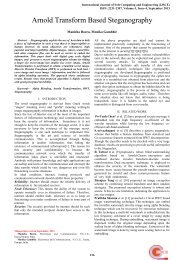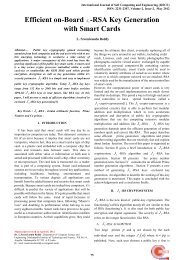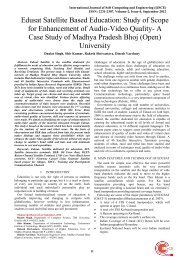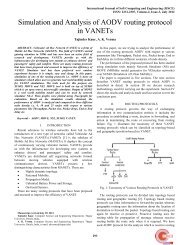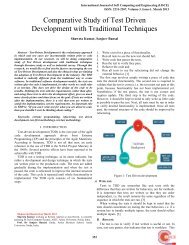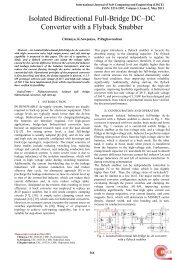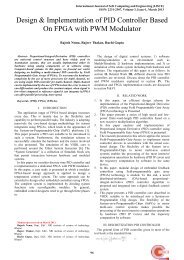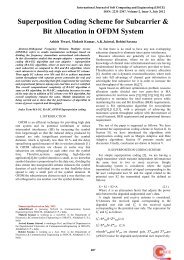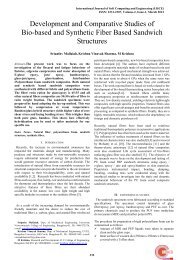Compact Microstrip Antenna for WLAN and H-LAN communication
Compact Microstrip Antenna for WLAN and H-LAN communication
Compact Microstrip Antenna for WLAN and H-LAN communication
Create successful ePaper yourself
Turn your PDF publications into a flip-book with our unique Google optimized e-Paper software.
International Journal of Soft Computing <strong>and</strong> Engineering (IJSCE)<br />
ISSN: 2231-2307, Volume-2, Issue-3, July 2012<br />
<strong>Compact</strong> <strong>Microstrip</strong> <strong>Antenna</strong> <strong>for</strong> <strong>W<strong>LAN</strong></strong> <strong>and</strong><br />
H-<strong>LAN</strong> Communication<br />
Samiran Chatterjee, Partha Pratim Sarkar, Debasree Ch<strong>and</strong>a (Sarkar), Santosh Kumar Chowdhury<br />
Abstract— A single layer, single feed compact rectangular<br />
antenna is proposed. Resonant frequency has been reduced<br />
drastically by cutting unequal rectangular slots at the edge of the<br />
patch & a circle in the middle. The width of the rectangular slots<br />
is different to improve the gain b<strong>and</strong>width per<strong>for</strong>mance of the<br />
antenna. The antenna size has been reduced by 41.8% when<br />
compared to a conventional rectangular microstrip patch<br />
antenna with a maximum of 24.9 MHz b<strong>and</strong>width at –16.3 dB<br />
return loss at 3.41 GHz. The characteristics of the designed<br />
structure are investigated by using MoM based electromagnetic<br />
solver, IE3D. There is reasonable agreement these simulated<br />
data <strong>and</strong> measured value. An extensive analysis of the return<br />
loss, radiation pattern, gain of the proposed antenna is shown in<br />
this paper. The simple configuration <strong>and</strong> low profile nature of<br />
the proposed antenna leads to easy fabrication <strong>and</strong> make it<br />
suitable <strong>for</strong> the applications in Wireless <strong>communication</strong> system.<br />
Keywords— <strong>Compact</strong>, Frequency ratio, Patch, Resonant<br />
frequency, Slot.<br />
I. INTRODUCTION<br />
In recent years dem<strong>and</strong> <strong>for</strong> small antennas on wireless<br />
<strong>communication</strong> has increased the interest of research work<br />
on compact microstrip antenna design among microwaves<br />
<strong>and</strong> wireless engineers [1]. To support the high mobility<br />
necessity <strong>for</strong> a wireless tele<strong>communication</strong> device, a small<br />
<strong>and</strong> light weight antenna is likely to be preferred. For this<br />
purpose <strong>Compact</strong> <strong>Microstrip</strong> antenna is one of the most<br />
suitable applications. The development of antenna <strong>for</strong><br />
wireless <strong>communication</strong> also requires an antenna with more<br />
than one operating frequency.<br />
Manuscript received: June10, 2012.<br />
Samiran Chatterjee, Electronics <strong>and</strong> Communication Engineering,<br />
Aryabhatta Institute of Engineering & Management, Durgapur, West<br />
Bengal, India,<br />
Partha Pratim Sarkar, Department of Engineering <strong>and</strong> Technological<br />
Studies, Kalyani University, Kalyani, Nadia, West Bengal, India,<br />
Debasree Ch<strong>and</strong>a (Sarkar), Department of Engineering <strong>and</strong><br />
Technological Studies, Kalyani University, Kalyani, Nadia, West Bengal,<br />
India,<br />
Santosh Kumar Chowdhury, Electronics <strong>and</strong> Communication<br />
Engineering, JIS College of Engineering, Phase-III, Kalyani, Nadia, West<br />
Bengal, India,<br />
270<br />
This is due to many reasons, mainly because there are<br />
various wireless <strong>communication</strong> systems <strong>and</strong> many<br />
tele<strong>communication</strong> operators using various frequencies.<br />
There<strong>for</strong>e one antenna that has multib<strong>and</strong> characteristic is<br />
more desirable than having one antenna <strong>for</strong> each frequency<br />
b<strong>and</strong>. To reduce the size of the antenna one of the effective<br />
techniques is cutting slot in proper position on the microstrip<br />
patch [2-4]. <strong>Compact</strong> microstrip antenna is a topic of<br />
intensive research in recent years because of increasing<br />
dem<strong>and</strong> <strong>for</strong> small antennas used in various types of<br />
<strong>communication</strong>s including mobile <strong>communication</strong> [5-8].<br />
The size of the antenna may be effectively reduced by<br />
cutting rectangular slots on printed antennas. The work to be<br />
presented in this paper is also a compact printed antenna<br />
obtained by cutting rectangular slots which gave a resonant<br />
frequency much lower than the resonant frequency of the<br />
conventional printed antenna with the same patch area. The<br />
work to be presented in this paper is also a compact<br />
microstrip antenna design obtained by cutting rectangular<br />
slots on the patch to increase the return loss <strong>and</strong> gainb<strong>and</strong>width<br />
per<strong>for</strong>mance of the antenna. To reduce the size of<br />
the antenna substrates are chosen with higher value of<br />
dielectric constant [9-14]. Our aim is to reduce the size of<br />
the antenna as well as increase the operating b<strong>and</strong>width. The<br />
proposed antenna (substrate with εr = 4.4) presents a size<br />
reduction of 41.8% when compared to a conventional<br />
rectangular microstrip patch. The simulation has been<br />
carried out by IE3D [15] software which uses the MOM<br />
method.<br />
II. ANTENNA DESIGN<br />
The configuration of the conventional printed antenna is<br />
shown in Figure 1 with L=16 mm, W=20 mm, substrate<br />
(PTFE) thickness h = 1.5875 mm, dielectric constant εr =<br />
4.4. Coaxial probe-feed (radius=0.5mm) is located at W/2<br />
<strong>and</strong> L/3.<br />
Assuming practical patch width W= 20 mm <strong>for</strong> efficient<br />
radiation <strong>and</strong> using the equation [6],<br />
fr =[c/(2*W)]*√(2/(1+ εr)), we determined the resonant<br />
frequency fr (= 4.57 GHz). Where, c = velocity of light in<br />
free space. Using the following equation [7, 8] we<br />
determined the practical length L (=16mm). L=Leff - 2∆L<br />
where, ∆L/h = 0.412*[((εreff+0.3)*(W/h+0.264))/(( εreff –<br />
0.258)*(W/h+0.))],<br />
εreff = (εr +1)/2 + (εr -1)/(2*√(1+12*h/W)) <strong>and</strong> Leff =<br />
[c/(2*fr * √εreff)] Where, Leff = Effective length of the patch,<br />
∆L/h =Normalized extension of the patch length, εreff =<br />
Effective dielectric constant.
<strong>Compact</strong> <strong>Microstrip</strong> <strong>Antenna</strong> <strong>for</strong> <strong>W<strong>LAN</strong></strong> <strong>and</strong> H-<strong>LAN</strong> Communication<br />
Figure 1: <strong>Antenna</strong> 1 configuration<br />
Figure 2 shows the configuration of antenna 2<br />
designed with similar PTFE substrate. Four unequal<br />
rectangular slots (L1, L2, L3, L4) <strong>and</strong> one circle whose<br />
dimensions <strong>and</strong> the location of coaxial probe-feed<br />
(radius=0.5 mm) are shown in the figure 2.<br />
Figure 2: <strong>Antenna</strong> 2 configuration<br />
III. RESULTS AND DISCUSSION<br />
Simulated (using IE3D [15] results of return loss in<br />
conventional <strong>and</strong> slotted antenna structures are shown in<br />
Figure 3-4. A significant improvement of frequency<br />
reduction is achieved in antenna 2 with respect to the<br />
conventional antenna1 structure.<br />
271<br />
Figure 3: <strong>Antenna</strong> 1 Return Loss vs. Frequency (Conventional <strong>Antenna</strong>)<br />
Figure 4: <strong>Antenna</strong> 2 Return Loss vs. Frequency (Slotted <strong>Antenna</strong>)<br />
In the conventional antenna return loss of about -17.212<br />
dB is obtained at 4.170 GHz. Corresponding 10 dB<br />
b<strong>and</strong>width is 70.91 MHz.<br />
Due to the presence of slots in antenna 2 resonant<br />
frequency operation is obtained with large values of<br />
frequency ratio. The resonant frequency is obtained at<br />
f1=3.412 GHz with return loss of about -16.30 dB. The<br />
second resonant frequency is obtained at f2 = 7.87 GHz with<br />
return losses -10.55 dB. Corresponding 10 dB b<strong>and</strong>width<br />
obtained <strong>for</strong> <strong>Antenna</strong> 2 at f1, f2 are 24.9 MHz, 19.12 MHz<br />
respectively.<br />
IV. RADIATION PATTERN<br />
For the antenna 1 (Conventional <strong>Antenna</strong>) radiation<br />
patterns of E plane & H plane are shown in Figure 5-6. The<br />
simulated E plane radiation pattern of antenna 1<br />
(Conventional <strong>Antenna</strong>) <strong>for</strong> 4.17 GHz is shown in figure 5.
Figure5: E plane Radiation Pattern <strong>for</strong> <strong>Antenna</strong> 1 at 4.17 GHz<br />
The simulated H plane radiation pattern of antenna 1<br />
(Conventional <strong>Antenna</strong>) <strong>for</strong> 4.17 GHz is shown in figure 6.<br />
Figure 6: H plane Radiation Pattern <strong>for</strong> <strong>Antenna</strong> 1 at 4.17 GHz<br />
For the antenna 2 (Slotted <strong>Antenna</strong>) radiation patterns of E<br />
plane & H plane are shown in Figure 7-10. The simulated E<br />
plane radiation pattern of antenna 2 (Slotted <strong>Antenna</strong>) <strong>for</strong><br />
3.41 GHz is shown in figure 7.<br />
Figure 7: E plane Radiation Pattern <strong>for</strong> <strong>Antenna</strong> 2 at 3.41 GHz<br />
International Journal of Soft Computing <strong>and</strong> Engineering (IJSCE)<br />
ISSN: 2231-2307, Volume-2, Issue-3, July 2012<br />
272<br />
The simulated H plane radiation pattern of antenna 2<br />
(Slotted <strong>Antenna</strong>) <strong>for</strong> 3.41 GHz is shown in figure 8.<br />
Figure 8: H plane Radiation Pattern <strong>for</strong> <strong>Antenna</strong> 2 at 3.41 GHz<br />
The simulated E plane radiation pattern of antenna 2 (Slotted<br />
<strong>Antenna</strong>) <strong>for</strong> 7.87 GHz is shown in figure 9.<br />
Figure 9: E plane Radiation Pattern <strong>for</strong> <strong>Antenna</strong> 2 at 7.87 GHz<br />
The simulated H plane radiation pattern of antenna 2<br />
(Slotted <strong>Antenna</strong>) <strong>for</strong> 7.87 GHz is shown in figure 10.<br />
Figure 10: H plane Radiation Pattern <strong>for</strong> <strong>Antenna</strong> 2 at 7.87 GHz<br />
All the simulated results are summarized in the following
<strong>Compact</strong> <strong>Microstrip</strong> <strong>Antenna</strong> <strong>for</strong> <strong>W<strong>LAN</strong></strong> <strong>and</strong> H-<strong>LAN</strong> Communication<br />
Table1 <strong>and</strong> Table2.<br />
TABLE I:<br />
SIMULATED RESULTS FOR ANTENNA 1 AND 2<br />
ANTENNA<br />
STRUCTURE<br />
ANTENNA<br />
STRUCTU<br />
RE<br />
RESONANT<br />
FREQUENCY<br />
(GHZ)<br />
RETURN<br />
LOSS<br />
(DB)<br />
10 DB<br />
BANDWIDTH<br />
(MHZ)<br />
1 f 1= 4.17 -17.212 70.91<br />
2 f 1= 3.41 -16.30 24.90<br />
f 2= 7.87 -10.55 19.12<br />
TABLE II:<br />
SIMULATED RESULTS FOR ANTENNA 1 AND 2<br />
RESONANT<br />
FREQUENC<br />
Y (GHz)<br />
FREQUENCY<br />
RATIO<br />
3 DB<br />
BEAM<br />
WIDTH<br />
( 0 )<br />
V. EXPERIMENTAL RESULTS AND DISCUSSION<br />
The prototype of the antenna 2 (proposed antenna) was<br />
fabricated <strong>and</strong> tested, which are depicted in Fig.s 11-12 the<br />
measurements were carried out using Vector Network<br />
Analyzer (VNA) Agilent N5 230A.<br />
Figure 11: Measured return loss <strong>for</strong> proposed antenna.<br />
ABSOLUT<br />
E GAIN<br />
(DBI)<br />
1 f1= 4.17 170.92 0 5.43<br />
2 f1= 3.41 170.52 0<br />
3.29<br />
f2= 7.87 f2/ f1= 2.308 101.33 0<br />
0.71<br />
Figure 12: Comparison between simulated & measured return loss <strong>for</strong><br />
proposed antenna.<br />
The comparisons of the measured return loss with the<br />
simulated ones <strong>for</strong> conventional antenna are shown in<br />
273<br />
Fig.13. Discrepancy between the measured <strong>and</strong> simulated<br />
results is due to the effect of improper soldering of SMA<br />
connector or fabrication tolerance.<br />
Figure 13: Comparison between simulated & measured return loss<br />
<strong>for</strong> conventional antenna.<br />
VI. CONCLUSION<br />
Theoretical investigations of a single layer single feed<br />
micro strip printed antennas have been carried out using<br />
Method of Moment based software IE3D. Introducing slots<br />
at the edge of the patch size reduction of about 41.8% has<br />
been achieved. The 3dB beam-width of the radiation pattern<br />
170.52° which is sufficiently broad beam <strong>for</strong> the<br />
applications <strong>for</strong> which it is intended.<br />
The resonant frequency antenna presented in the paper <strong>for</strong><br />
a particular location of feed point (3mm, 3mm considering<br />
the centre as the origin) was quite large as is evident from<br />
table1. Alteration of the location of the feed point results in<br />
narrower 10dB b<strong>and</strong>width <strong>and</strong> less sharp resonances.<br />
ACKNOWLEDGEMENT<br />
We acknowledge gratefully the financial support <strong>for</strong> this<br />
work provided by AICTE (India) in the <strong>for</strong>m of a project<br />
entitled “DEVELOPMENT OF COMPACT,<br />
BROADBAND AND EFFICIENT PATCH ANTENNAS<br />
FOR MOBILE COMMUNICATION”.<br />
REFERENCES<br />
1. I. Sarkar, P. P. Sarkar, S. K. Chowdhury A new compact printed<br />
antenna <strong>for</strong> mobile <strong>communication</strong>. 2009 Loughborough <strong>Antenna</strong>s &<br />
Propagation Conference 16-17 Nov. 2009, Loughborough, UK.<br />
2. J.-W. Wu, H.-M. Hsiao, J.-H. Lu <strong>and</strong> S.-H. Chang, “Dual broadb<strong>and</strong><br />
design of rectangular slot antenna <strong>for</strong> 2.4 <strong>and</strong> 5 GHz wireless<br />
<strong>communication</strong>”, IEE Electron. Lett. Vol. 40 No. 23,11th November<br />
2004.<br />
3. Samiran Chatterjee, Joydeep Paul, Kalyanbrata Ghosh, P. P. Sarkar,<br />
D.Ch<strong>and</strong>a (Sarkar) <strong>and</strong> S. K. Chowdhury “A <strong>Compact</strong> <strong>Microstrip</strong><br />
<strong>Antenna</strong> <strong>for</strong> <strong>W<strong>LAN</strong></strong> Communication”, National Conference of<br />
Electronics, Communication <strong>and</strong> Signal Processing, 2011, Paper ID:<br />
116<br />
4. Rohit K. Raj, Monoj Joseph, C.K. An<strong>and</strong>an, K. Vasudevan, P.<br />
Mohanan, “ A New <strong>Compact</strong> <strong>Microstrip</strong>-Fed Dual-B<strong>and</strong> Coplaner<br />
<strong>Antenna</strong> <strong>for</strong> <strong>W<strong>LAN</strong></strong> Applications”, IEEE Trans. <strong>Antenna</strong>s Propag.,<br />
Vol. 54, No. 12, December 2006, pp 3755-3762.<br />
5. U. Chakraborty, S. Chatterjee, S. K. Chowdhury, <strong>and</strong> P. P. Sarkar,<br />
“Triangular Slot <strong>Microstrip</strong> Patch <strong>Antenna</strong> <strong>for</strong> Mobile<br />
Communication”, India Conference (INDICON), 2010 Annual IEEE,<br />
pp 4-7, Paper ID: 511
6. J. -Y. Jan <strong>and</strong> L. -C. Tseng, “ Small planar monopole <strong>Antenna</strong> with a<br />
shorted parasitic inverted-L wire <strong>for</strong> Wireless <strong>communication</strong>s in the<br />
2.4, 5.2 <strong>and</strong> 5.8 GHz b<strong>and</strong>s” , IEEE Trans. <strong>Antenna</strong>s <strong>and</strong> Propag.,<br />
VOL. 52, NO. 7, July 2004, pp -1903-1905.<br />
7. S. Chatterjee, U. Chakraborty, I.Sarkar, S. K. Chowdhury, <strong>and</strong> P. P.<br />
Sarkar, “A <strong>Compact</strong> <strong>Microstrip</strong> <strong>Antenna</strong> <strong>for</strong> Mobile<br />
Communication”, India Conference (INDICON), 2010 Annual IEEE,<br />
pp 1-3, Paper ID: 510<br />
8. Danideh, A., R. S. Fakhr, <strong>and</strong> H. R. Hassani, “Wideb<strong>and</strong> coplanar<br />
microstrip patch antenna,” Progress In Electromagnetics<br />
Research Letters, PIER 4, 81–89, 2008.<br />
9. Samiran Chatterjee, Joydeep Paul, Kalyanbrata Ghosh, P. P. Sarkar<br />
<strong>and</strong> S. K. Chowdhury “A Printed Patch <strong>Antenna</strong> <strong>for</strong> Mobile<br />
Communication”, Convergence of Optics <strong>and</strong> Electronics conference,<br />
2011, Paper ID: 15, pp 102-107<br />
10. J. Bahl <strong>and</strong> P. Bhartia, “ <strong>Microstrip</strong> <strong>Antenna</strong>s”, Artech House,<br />
Dedham, MA, 1980.<br />
11. U. Chakraborty, S. Chatterjee, S. K. Chowdhury, <strong>and</strong> P. P. Sarkar, "A<br />
compact microstrip patch antenna <strong>for</strong> wireless <strong>communication</strong>,"<br />
Progress In Electromagnetics Research C, Vol. 18, 211-220, 2011<br />
12. R.Fallahi, A.-A.Kalteh, M. Golparvar Roozbahani, "A novel UWB<br />
elliptical slot antenna with b<strong>and</strong>-notched characteristics," Progress In<br />
Electromagnetics Research C, Vol. 18, 211-220, 2011<br />
13. E. O. Hammerstad, “ Equations <strong>for</strong> <strong>Microstrip</strong> Circuit Design”, Proc.<br />
Fifth European Microwave Conf. Pp 268-272, September 1975.<br />
14. C. A. Balanis, “Advanced Engineering Electromagnetic”, John Wiley<br />
& Sons., New York, 1989.<br />
15. Zel<strong>and</strong> Software Inc. IE3D: MOM-Based EM Simulator. Web:<br />
http://www.zel<strong>and</strong>.com<br />
International Journal of Soft Computing <strong>and</strong> Engineering (IJSCE)<br />
ISSN: 2231-2307, Volume-2, Issue-3, July 2012<br />
274



